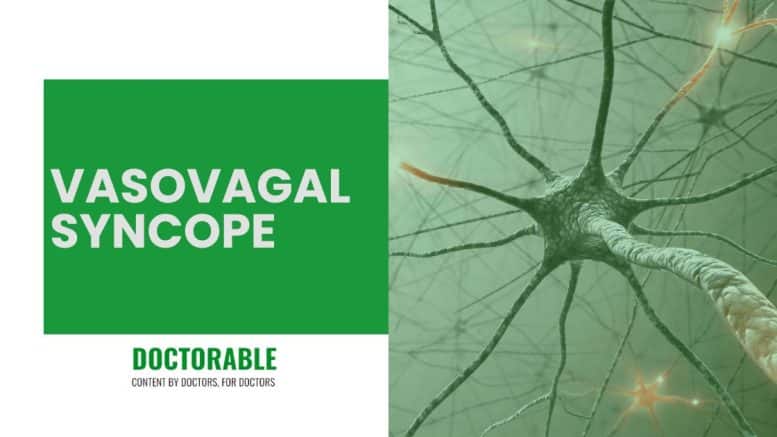Summary
Contents showA vasovagal syncope is a form of reflex syncope produced by a complex set of autonomic reflexes triggered by several factors in at-risk populations.
Vasovagal syncope is a common condition presenting in young as well as elder adults. It is associated with an increased risk of injuries and episodes of recurrence.
Diagnosis and management of vasovagal syncope rely on a complete clinical assessment, evaluation of differential diagnoses, and further diagnostic studies in selected patients, especially in those in whom a differential diagnosis is suspected.
Vasovagal Syncope – Introduction
One of the most prevalent forms of reflex syncope is a vasovagal episode or vasovagal syncope. Other forms of reflex syncope also include situational syncope and carotid sinus syncope.
Reflex syncope is known as an episode caused by a flaw or failure in the autoregulation system of blood pressure. When a human is exposed to certain factors, they trigger a parasympathetic nervous system response, causing a decrease in heart rate and dilation of blood vessels. Eventually, this results in low blood pressure and a drop in cerebral perfusion pressure. Due to this drop, the brain runs low on basic necessities such as oxygen and major nutrients. This loss causes a small fit of unconsciousness. (1)
Vasovagal syncope is known to be a terrifying syndrome. It can also be described as neurocardiogenic syncope or neurally mediated syncope. Normally, women under the age of 40 experience symptoms and triggers relating to vasovagal syncope. Some older patients may be diagnosed with this syncope but are more likely to merely show atypical symptoms. (2)
Epidemiology of Vasovagal Syncope
Studies related to syncope have reported prevalence rates of 41%, with recurrence having a rate of 13.5%, within the age range. The prevalence rate was shown to be 19%, with females having a higher prevalence.
First, episodes were found to be more common in people around 20, 60, or 80 years of age and even occurring 5 to 7 years earlier in males.
Elderly adults also show a greater likelihood of hospitalization and death due to syncope, with the National Hospital Ambulatory Medical Care Survey reporting 6.7 million cases of syncope in emergency care. Out of these, 58% were patients older than 80 years of age. The prevalence of syncope as a symptom in the emergency department was observed to range from 0.8% to 2.4% in multiple studies that were conducted on the academic level as well as by the medicinal community. (3)
To conclude, it must be understood that syncope is a common condition having a high prevalence rate and a risk of recurrence. Management of syncope in elderly individuals requires proper evaluation to significantly reduce the risk of recurrent episodes and adverse outcomes. Healthcare providers should show vigilance in identifying and managing potential risk factors regarding syncope in elderly adults to better optimize patient care.
Signs and symptoms of Vasovagal Syncope
The main symptoms associated with this syncope include :
- Nausea;
- Pallor;
- Diaphoresis;
- Muscle twitching;
- Confusion;
- Physical injury;
- Palpitations;
- Dyspnea;
- Chest pain;
- Cyanosis (4).
Subjects have reported experiencing an unexpected feeling of warmth, epigastric comfort, vague nausea, and abdominal cramps. Some people have an extreme urge to defecate. If these warnings are heeded, and the individual decides to sit or lay down, then syncope may be prevented. However, ignoring these signs leads to light-headedness, dizziness, cold sweat or a ‘swimming’ sensation, fatigue, sounds coming from a distance, and buzzing in the ears may occur. (5).
Etiology and Triggers
The classical etiological factors include:
- Emotional stress;
- Noxious stimuli;
- Fear of injury;
- Prolonged standing;
- Heat exposure;
- Physical exertion.
Clinical history of patients should be completely performed, and each episode of syncope should be well characterized about the presence of prodrome, factors, conditions in which it occurred, the position of the patient, and all present symptoms such as nausea, pallor, and dyspnea, among others. Personal medical and family histories are extremely significant in the process of identifying the causes of syncope (4).
Precipitating factors
Some factors leading to syncope may also include a prolonged sitting or standing position, venous puncture, alcohol use, dehydration, and use of diuretics and vasodilators (4).
Injuries caused
A study indicates that patients admitted to a hospital with syncope have an 80% higher risk of injury in the following year. A 2021 analysis of 23 studies involving a total of 3593 patients that were diagnosed with vasovagal syncope found that about 33.5% of individuals reported a history of traumatic syncopal episodes (6). The above observations hence show injury as an outcome of syncope. However, despite these, there is barely any information about the risk factors of syncope-related injuries. Identifying clinical associations of these injuries is an important step in improving the treatment and management of syncope.
Pathophysiology of Vasovagal Syncope
Vasovagal syncope is best explained by the Bezold-Jarisch reflex, which involves a variety of processes and is caused by decreased venous return as upright posture results in the pooling of blood in the lower extremities. This leads to the stimulation of sympathetic activity by carotid sinus baroreceptors and causes improper ventricular filling and extreme cardiac contraction.
It may occur by the action of myelinated A fibers as well as mechanoreceptors (C fibers) that are preferentially located in the inferolateral wall of the left ventricle and also in the atria and the pulmonary artery, which in turn results in hypotension and paradoxical bradycardia as well, due to the high activity of inhibitory receptors and consequent activation of the parasympathetic system (7).
Diagnosis and Management
Many forms of advanced technology, provocation tests, and different methods for diagnosis have been created to diagnose vasovagal syncope. A large amount of in-depth history and detailed examination is necessary for diagnosis (8, 9). The identification of life-threatening conditions in which syncope is the only indicator of a hidden cardiovascular disease is necessary. Many experts recommend a standard 12-lead electrocardiography (ECG) as a way to rule out disturbances in heart rate or rhythm (10). In any patient having a history of cardiac disease or heart murmurs, Echocardiography and stress-ECG are justified.
Due to the many causes of syncope, treatment cannot be applied without prior knowledge of the mechanism of syncope. The main innovations and ideas for diagnosis in recent years include:
- Tilt-table testing;
- Isometric counter-pressure maneuver;
- Lower limb compression bandage;
- Therapy guided by external and implantable loop recorder (ILR) in patients with recurrent suspected neurally-mediated syncope.
Drug therapy for vasovagal syncope still lacks sufficient research. Some drugs, such as midodrine, beta-blockers, and serotonin reuptake inhibitors, showed results in patients having recurring vasovagal syncope.
The main form of therapy for young patients having vasovagal syncope is education and reassurance, except in rare cases of patients having a high frequency of recurrent episodes.
In elderly people, treatment of a specific kind is not always necessary. These patients have to be managed through the determination of the hemodynamic mechanism of spontaneous syncope by means of an external or implantable cardiac monitor. However, limited data exist on the role of medicinal drugs in the treatment of older patients. (10)
An informative discussion with the patient about the nature and prognosis is the first step in the treatment of patients having syncope. Conditions triggering the syncope may be avoided, such as a hot environment, humid atmosphere, prolonged standing, and reduced water intake. Discontinuing hypotensive drug treatments is a significant measure for the prevention of recurrences in many subjects, including elderly patients. Substituting salt and intake of isotonic drinks expands the circulating blood and may improve venous return. (10)
Differential Diagnosis
These include:
- Psychogenic Pseudosyncope;
- Postural Orthostatic Hypotension;
- Metabolic derangements;
- Acute Coronary Syndrome;
- Ventricular Arrhythmias;
- Atrioventricular Heart Blocks;
- Wolff-Parkinson-White Syndrome.
Disclosures
The author does not report any conflict of interest.
Disclaimer
This information is for educational purposes and is not intended to treat disease or supplant professional medical judgment. Physicians should follow local policy regarding the diagnosis and management of medical conditions.
See Also
Introducing Valvular Heart Disease
Heart Failure with Preserved Ejection Fraction
Dyspnea Due to Respiratory Causes
Diagnosis and Management of Anaphylaxis
References
- Jeanmonod R, Sahni D, Silberman M. Vasovagal Episode. Vasovagal Episode – StatPearls – NCBI Bookshelf (nih.gov)
- Benditt D, Kowey P, Yeon SB. Reflex syncope in adults and adolescents: Clinical presentation and diagnostic evaluation. Reflex syncope in adults and adolescents: Clinical presentation and diagnostic evaluation – UpToDate
- Shen, W. K., Sheldon, R. S., Benditt, D. G., et al. (2021). 2017 ACC/AHA/HRS Guideline for the Evaluation and Management of Patients with Syncope: A Report of the American College of Cardiology/American Heart Association Task Force on Clinical Practice Guidelines and the Heart Rhythm Society. Circulation, 136(5), e60-e122. 2017 ACC/AHA/HRS Guideline for the Evaluation and Management of Patients With Syncope: A Report of the American College of Cardiology/American Heart Association Task Force on Clinical Practice Guidelines and the Heart Rhythm Society – PubMed (nih.gov)
- da Silva RM. Syncope: epidemiology, etiology, and prognosis. Frontiers in physiology. 2014 Dec 8;5:471. Syncope: epidemiology, etiology, and prognosis – PubMed (nih.gov)
- Wieling W, Thijs RD, Van Dijk N, Wilde AA, Benditt DG, Van Dijk JG. Symptoms and signs of syncope: a review of the link between physiology and clinical clues. Brain. 2009 Oct 1;132(10):2630-42. Symptoms and signs of syncope: a review of the link between physiology and clinical clues – PubMed (nih.gov)
- Jorge JG, Raj SR, Teixeira PS, Teixeira JA, Sheldon RS. Likelihood of injury due to vasovagal syncope: a systematic review and meta-analysis. EP Europace. 2021 Jul;23(7):1092-9. Likelihood of injury due to vasovagal syncope: a systematic review and meta-analysis | EP Europace | Oxford Academic (oup.com)
- Aydin MA, Salukhe TV, Wilke I, Willems S. Management and therapy of vasovagal syncope: a review. World Journal of Cardiology. 2010 Oct 26;2(10):308-15. Management and therapy of vasovagal syncope: A review – PubMed (nih.gov)
- Morillo CA. Evidence-based common sense: the role of clinical history for the diagnosis of vasovagal syncope. Eur Heart J. Evidence-based common sense: the role of clinical history for the diagnosis of vasovagal syncope – PubMed (nih.gov)
- Sheldon R, Rose S, Connolly S, Ritchie D, Koshman ML, Frenneaux M. Diagnostic criteria for vasovagal syncope based on a quantitative history. European heart journal. 2006 Feb 1;27(3):344-50. Diagnostic criteria for vasovagal syncope based on a quantitative history – PubMed (nih.gov)
- Grubb BP. Neurocardiogenic syncope. New England Journal of Medicine. 2005 Mar 10;352(10):1004-10. Neurocardiogenic Syncope | NEJM

